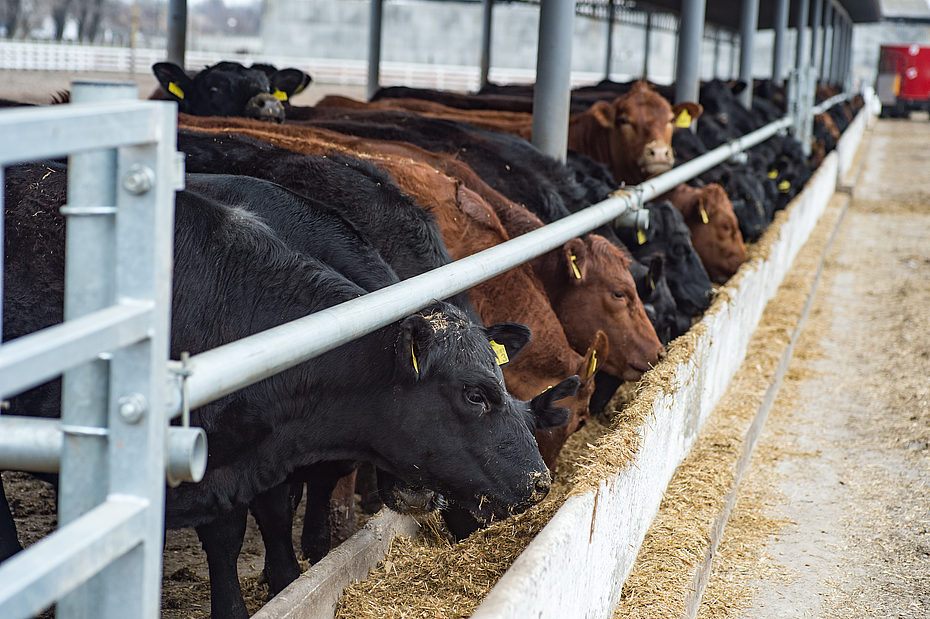Feeding grain based feedlot rations to cattle offers farmers the flexibility to finish cattle quickly and take advantage of good quality feeder cattle, good feed prices or favourable markets.
In order to take advantage of these opportunities, small and large feedlot operators must look at all the factors involved with feedlotting, and in particular the management of cattle being fed high grain diets. Adaptation of cattle onto these high grain diets is of critical importance and may often determine the success of feedlotting ventures.
Moisture Content of Diets
The feeding directions for concentrates are on an ‘As Fed’ basis for a typical rolled grain/hay diet which will have a Dry Matter content around 88-90%. If high moisture ingredients such as silage, vegetable or fruit by products, brewers grains etc are used the addition rate of the concentrate will be LESS.
Contact your Riverina Sales Representative to confirm the addition rate before using the concentrate.
Listed below is some animal husbandry information to help feedlot managers achieve the most out of feeding RIVERINA FEEDLOT RATIONS to cattle.
Adapting Cattle to Riverina Feedlot Rations
When cattle enter the feedlot yard they should be fed a palatable grassy or cereal hay for the first two (2) days (DO NOT USE LUCERNE HAY OR OTHER LEGUME HAY) to ensure the rumen is full before any grain feeding commences.
When cattle arrive at the feedlot they are usually vaccinated with ‘5 in 1’ or ‘7 in 1’, ear tagged or identified, dehorned, drenched, given a Vitamin A, D & E injection, BRD vaccine and weighed.
It is advisable to have your veterinarian check the animals to ensure that there are no health problems that may reduce their performance in the feedlot.
From after the first 2 days to finish cattle should have unlimited access to grassy hay or cereal straw at ALL TIMES. This roughage should be no less than 20% of the total feed intake, on a dry matter basis.
Start by feeding the animals small amounts of the feedlot grain ration.
A rumen buffer should be used during the starter phase as this will aid in the prevention of acidosis. Sodium bentonite at 2% or sodium bicarbonate or acid buf at 0.5 – 1.0% of the ration is usually adequate. (Already added to RIVERINA FEEDLOT PELLETS/MEAL & RIVERINA STUD PELLETS/MEAL).
SELF FEEDERS – During the introduction period the slides should be all the way down to a finger width. Cattle should have to work to lick the feedlot mix. Good management is essential and troughs should be checked regularly to ensure the feed is flowing and stale material is removed. The slides can gradually be adjusted upwards over 3 weeks till they are on full feed. The self-feeders must never be allowed to run out of feed.
FEEDBUNKS should have feed in them most of the time. If cattle are out of feed for a period of time they may gorge themselves which will lead to acidosis.
Remove spoiled feed before refilling troughs.
The cattle MUST have unlimited access to cool, clean WATER. Troughs should be cleaned twice a week.
Over a three week period, gradually increase the amount of the grain fed, so that after the adaptation period, the animals can have unlimited access to the grain diet. See the sample introduction programs for each product.
Grain and roughage sources should be of good quality and free from mould. Grain should be tested for protein. Low protein grains may require additional protein meals to be added to the diet.
The major grains used are barley, sorghum, corn & wheat. If using wheat good management is essential because the starch degradation is faster than other grains. Grains should be rolled. Hammer milling is not recommended as this will lead to an increased incidence of acidosis.
Shy Feeders – Not all cattle will perform well in a feedlot. There will always be a certain number of cattle that will not start and thus will not grow well. If these animals can be identified early, they can be culled from the yard and fattened on pasture. If left in the feedlot, these animals will reduce profitability by wasting feed.





 Beef
Beef
 Dairy
Dairy
 Sheep
Sheep
 Horse
Horse
 Pig
Pig
 Goat
Goat
 Poultry
Poultry
 Bird
Bird
 Dog
Dog
 Special
Special
 Feed Materials
Feed Materials